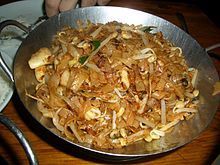This article has multiple issues. Please help improve it or discuss these issues on the talk page. (Learn how and when to remove these template messages)
|

| Part of a series on |
| Chinese cuisine |
|---|
 |
Malaysian Chinese cuisine is derived from the culinary traditions of Chinese Malaysian immigrants and their descendants,[citation needed] who have adapted or modified their culinary traditions under the influence of Malaysian culture as well as immigration patterns of Chinese to Malaysia. Because the vast majority of Chinese Malaysians are descendants of immigrants from southern China, Malaysian Chinese cuisine is predominantly based on an eclectic repertoire of dishes with roots from Fujian, Cantonese, Hakka and Teochew cuisines.[citation needed]
As these early immigrants settled in different regions throughout what was then British Malaya and Borneo, they carried with them traditions of foods and recipes that were particularly identified with their origins in China, which gradually became infused with the characteristics of their new home locale in Malaysia while remaining distinctively Chinese.[citation needed] For example, Hainanese chicken rice is usually flavoured with tropical pandan leaves and served with chilli sauce for dipping, and tastes unlike the typical chicken dishes found in Hainan Island itself. Some of these foods and recipes became closely associated with a specific city, town or village, eventually developing iconic status and culminating in a proliferation of nationwide popularity in the present day.[citation needed]
Chinese food is especially prominent in areas with concentrated Chinese communities, at roadside stalls, hawker centres and kopitiam, as well as smart cafes and upmarket restaurants throughout the nation.[citation needed] Many Chinese dishes have pork as a component ingredient, but chicken is available as a substitution for Muslim customers from the wider community, and some Chinese restaurants are even halal-certified.[citation needed]
© MMXXIII Rich X Search. We shall prevail. All rights reserved. Rich X Search
